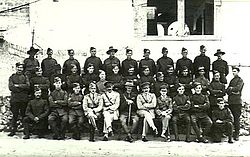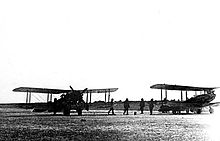- No. 40 Wing RAF
-
No. 40 Wing RAF 
Headquarters 40th (Army) Wing RAF, Palestine, 1918Active 5 October 1917 – 1 April 1920 Country United Kingdom Branch British Army (before 1 April 1918)
Royal Air Force (after 1 April 1918)Type Aircraft Role Counter-air
Bombing
Photo-reconnaissanceSize 4 squadrons Part of Palestine Brigade Base Ramleh (1918)
Ismailia (1919–20)Engagements Battle of Megiddo Commanders Notable
commandersAmyas Borton
Richard WilliamsAircraft flown Bomber Airco DH.9
Handley Page O/400Fighter Bristol F.2 Fighter
Royal Aircraft Factory S.E.5No. 40 Wing was a wing that formed part of the Royal Air Force (RAF) Palestine Brigade during World War I and immediately after. It was established in October 1917 as 40th (Army) Wing, Royal Flying Corps (RFC), and become part of the RAF in April 1918, when the RFC merged with the Royal Naval Air Service. The wing played a major part in the Battle of Megiddo, the last great offensive against the Ottoman Empire, in September 1918. It was disbanded in April 1920.
Contents
History
40th (Army) Wing RFC was formed on 5 October 1917,[1] under the control of the RFC's Palestine Brigade. Its primary roles were counter-air operations and attacks on enemy infrastructure. It also undertook extensive photo-reconnaissance work. Another formation under the Palestine Brigade, 5th (Corps) Wing, performed air cooperation and close air support tasks.[2] 40th Wing's first Officer Commanding was Lieutenant Colonel Amyas Borton;[3] he was succeeded by Alexander Shekleton in late 1917.[4] In June 1918, Lieutenant Colonel Richard Williams of the Australian Flying Corps (AFC) took command of the wing, with No. 1 Squadron AFC and three RFC squadrons—Nos. 111, 144, and 145—at his disposal.[5] No. 145 Squadron was also commanded by an Australian, Captain Roy Drummond.[6][7] Based at Ramleh, the wing's inventory consisted of Bristol F.2B and S.E.5 fighters and DH.9 light bombers.[5]
Augmented by a giant Handley Page bomber, No. 40 Wing took part in the Battle of Megiddo, General Allenby's final offensive in Palestine, where its units inflicted "wholesale destruction" on Turkish columns through sustained aerial assaults.[8][9] At Wadi Fara on 21 September 1918, the Palestine Brigade, including the 40th Wing's four squadrons, destroyed the bulk of the Turkish Seventh Army as it attempted to cross the Jordan River along an old Roman road leading from Nablus, an early demonstration of the effects of concentrated air attack on ground troops.[10] Williams wrote: "The Turkish Seventh Army ceased to exist and it must be noted that this was entirely the result of attack from the air." A detachment from No. 1 Squadron also aided Major T. E. Lawrence's Arab army north of Amman when it was harassed by German aircraft operating from Deraa.[11]
While the wing's actions during the Battle of Megiddo "assured Allenby's victory" according to historian Lawrence James, the new method of waging war by inflicting "sickening slaughter" from the air provoked a strong reaction from Lieutenant General Edward Bulfin, commander of the British XXI Corps. He confronted Major General Geoffrey Salmond, Air Officer Commanding RAF Middle East, with the comment, "You are a butcher—you call that fighting?"[9]
No. 40 Wing was based at RAF Ismailia in Egypt from 1919, and disbanded on 1 April 1920.[1]
Order of battle
Prior to the Battle of Megiddo in September 1918, No. 40 Wing consisted of the following units and equipment:[5]
- Headquarters – Ramleh
- No. 1 Squadron AFC (Bristol F.2B, Handley Page Type O)
- No. 111 Squadron RAF (S.E.5)
- No. 144 Squadron RAF (DH.9)
- No. 145 Squadron RAF (S.E.5)
Notes
- ^ a b Wing Nos 1–50 at Air of Authority — A History of RAF Organisation. Retrieved on 28 February 2009.
- ^ Mordike, RAF Air Power Review, pp. 18–19.
- ^ Air Vice-Marshal A E Borton at Air of Authority – A History of RAF Organisation. Retrieved on 28 February 2009.
- ^ "111(F) Sqn History". http://www.111sqn.com/History.htm. Retrieved 8 March 2009.[dead link]
- ^ a b c Mordike, RAF Air Power Review, pp. 28–9; 35.
- ^ Air Marshal Sir Peter Drummond at Air of Authority — A History of RAF Organisation. Retrieved on 28 February 2009.
- ^ Drummond, Sir Peter Roy Maxwell (1894–1945) at Australian Dictionary of Biography Online. Retrieved 28 February 2009.
- ^ Stephens, The Royal Australian Air Force, pp. 13–4.
- ^ a b Mordike, RAF Air Power Review, pp. 33–6.
- ^ Coulthard-Clark, The Encyclopaedia of Australia's Battles, pp. 160–61.
- ^ Odgers, 100 Years of Australia at War, pp. 84–5.
References
- Coulthard-Clark, Chris (2001). The Encyclopaedia of Australia's Battles. Crows Nest, NSW: Allen & Unwin. ISBN 1865086347.
- Cutlack, F.M. (1941) [1923]. The Official History of Australia in the War of 1914-1918 (11th edition): Volume VIII – The Australian Flying Corps in the Western and Eastern Theatres of War, 1914–1918. Sydney: Angus & Robertson. http://www.awm.gov.au/histories/chapter.asp?volume=9.
- Mordike, John (2002). "General Sir Edmund Allenby's joint operations in Palestine, 1917-1918". The Royal Air Force Air Power Review, Volume 5, Number 4 (Swindon, Wiltshire: Director of Defence Studies (RAF)). http://www.raf.mod.uk/rafcms/mediafiles/49896C98_1143_EC82_2E67619953626AC0.pdf.
- Odgers, George (1999) [1994]. 100 Years of Australia at War. Sydney: Lansdowne. ISBN 186302669X.
- Stephens, Alan (2006) [2001]. The Royal Australian Air Force: A History. London: Oxford University Press. ISBN 0195555414.
Categories:- Royal Flying Corps wings
- Royal Air Force wings
- Military units and formations established in 1917
- Military units and formations disestablished in 1920
- Military units and formations of the Royal Air Force in World War I
- 1917 establishments in the United Kingdom
Wikimedia Foundation. 2010.


